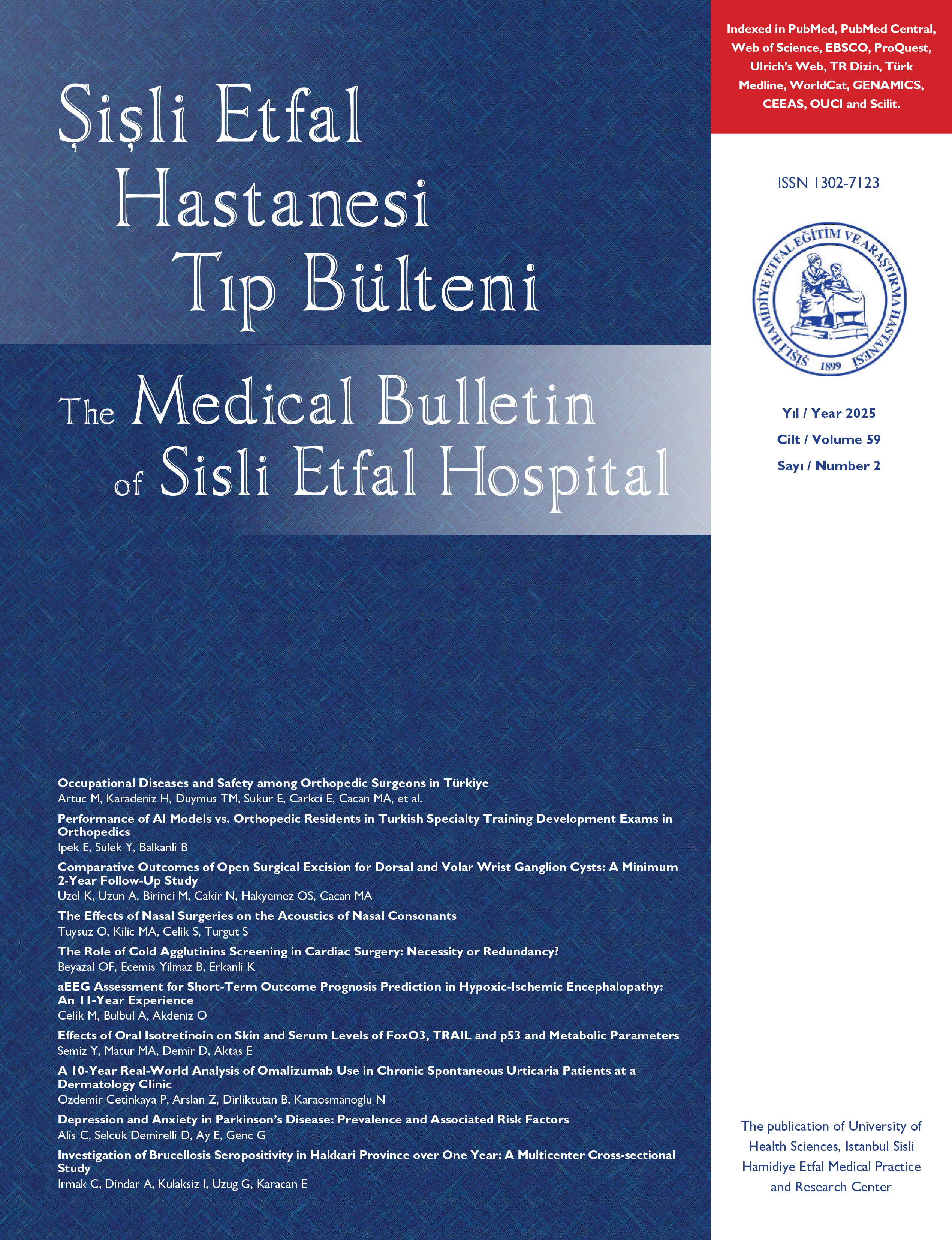
Tip 1 Diabetes Mellituslu Çocuklarda Yaşam Kalitesi ve Psikososyal Sorunların Değerlendirilmesi
Elida Yuksel1, Lida Bulbul2, Semra Yilmaz3, Sami Hatipoglu4, Esra Deniz Papatya Cakir51Acıbadem Atakent Hastanesi, Çocuk Sağlığı ve Hastalıkları Kliniği, İstanbul2Türkiye Sağlık Bilimleri Üniversitesi, Bağcılar Eğitim ve Araştırma Hastanesi, Pediatrik Alerji ve İmmünoloji Kliniği, İstanbul
3Memorial Bahçelievler Hastanesi, Çocuk Psikiyatrisi Kliniği, İstanbul
4Türkiye Sağlık Bilimleri Üniversitesi, Bakırköy Sadi Konuk Eğitim ve Araştırma Hastanesi, Çocuk Sağlığı ve Hastalıkları Kliniği, İstanbul
5Türkiye Sağlık Bilimleri Üniversitesi, Bakırköy Sadi Konuk Eğitim ve Araştırma Hastanesi, Pediatrik Endokrinoloji Kliniği, İstanbul
Amaç: Tip 1 diyabetli (T1DM) 8-18 yaş arası çocuk ve ergenlerde psikososyal sorunların sıklığını ve yaşam kalitesini etkileyen faktörleri değerlendirmek.
Gereç ve Yöntem: Çalışmada, T1DM tanısıyla en az 6 ay boyunca takip edilen 8-18 yaş arası çocuk ve ergenler değerlendirilerek, sağlıklı çocuk ve ergenlerle karşılaştırıldı. Her iki grubun hastalık takibi ve sosyodemografik özelliklerine ilişkin veriler çalışma formuna kaydedildi. Ayrıca her iki gruba da Çocuklarda Depresyon Envanteri (CDI), Çocuklarda Anksiyete İle İlgili Bozukluklar Taraması (SCARED) ve Çocuklarda Yaşam Kalitesi Anketi (KINDL: KINDerLebensqualitätsfragebogen) uygulandı. T1DM grubu ile kontrol grubunun ölçek puanları karşılaştırıldı.
Bulgular: Bu çalışma için 81'i T1DM grubunda ve 100'ü kontrol grubunda olmak üzere toplam 181 çocuk veya ergen değerlendirildi. Ortalama yaş T1DM grubunda 13,1±2,4 yıl, kontrol grubunda ise 12,4±2,1 yıl idi. Ortalama CDI, SCARED ve KINDL puanları sırasıyla; T1DM grubunda 15,3±7,2, 23,6±11,9, 53,5±13,7, kontrol grubunda ise 7,9±6,8, 14,7±13, 60±11,6 idi. İki grup arasında ortalama CDI, SCARED ve KINDL skorları açısından istatistiksel olarak anlamlı fark vardı (tüm p değerleri <0,001). Evde diyabet diyetine uyum azaldıkça ortalama CDI skorunda anlamlı artış (p=0,005), KINDL skorunda ise anlamlı düşüş (p=0,002) görüldü. Ev dışında diyabetik diyete uyum azaldıkça KINDL skorunun anlamlı düzeyde azaldığı görüldü (p=0,001).
Sonuç: T1DM'li çocuklarda sağlıklı çocuklara göre yaşam kalitesi daha düşük, depresyon ve anksiyete düzeyleri daha yüksektir. Bu nedenle Tip 1DM'li çocuklara tanı anından itibaren psikososyal destek sağlanması gerekmektedir. (SETB-2024-01-013)
Anahtar Kelimeler: Anksiyete, çocuk, depresyon, yaşam kalitesi, tip 1 diyabet
Evaluation of Quality of Life and Psychosocial Problems in Children with Type 1 Diabetes Mellitus
Elida Yuksel1, Lida Bulbul2, Semra Yilmaz3, Sami Hatipoglu4, Esra Deniz Papatya Cakir51Department of Pediatrics, Acibadem Atakent Hospital, Istanbul, Türkiye2Department of Pediatric Allergy and Immunology, University of Health Science Türkiye, Bagcilar Training and Research Hospital, Istanbul, Türkiye
3Department of Pediatric Psychiatry, Memorial Bahcelievler Hospital, Istanbul, Türkiye
4Department of Pediatrics, University of Health Science Türkiye, Bakirkoy Sadi Konuk Training and Research Hospital, Istanbul, Türkiye
5Department of Pediatric Endocrinology, University of Health Science Türkiye, Bakirkoy Sadi Konuk Training and Research Hospital, Istanbul, Türkiye
Objectives: To evaluate the frequency of psychosocial problems and the factors affecting the quality of life in children and adolescents aged between 8 and 18 years with type 1 diabetes mellitus (T1DM).
Methods: In the study, children and adolescents aged between 8 and 18 years who had been followed for at least 6 months for T1DM were evaluated (T1DM group), and compared with healthy children and adolescents who applied to the general pediatric outpatient clinic and did not have any chronic disease (control group). Data on disease follow-up of children and adolescents with T1DM were obtained from medical records. Sociodemographic characteristics of both groups were recorded in the study form. In addition, the Children's Depression Inventory (CDI), Screen for Child Anxiety Related Disorders (SCARED) and Children Quality of Life Questionnaire (KINDL: KINDerLebensqualitätsfragebogen) were applied to both groups. The scale scores of the T1DM group and the control group were compared. Factors affecting the scale scores of the T1DM group were evaluated.
Results: A total of 181 children or adolescents, 81 of whom were in the T1DM group and 100 in the control group, were evaluated for this study. The mean age was 13.1±2.4 years in the T1DM group and 12.4±2.1 years in the control group. The mean CDI, SCARED, and KINDL scores, respectively; it was 15.3±7.2, 23.6±11.9, and 53.5±13.7 in the T1DM group and 7.9±6.8, 14.7±13, 60±11.6 in the control group. There was a statistically significant difference between the two groups in terms of mean CDI, SCARED, and KINDL scores (all p values <0.001). As compliance with the diabetic diet decreased at home, there was a significant increase in the mean CDI score (p=0.005) and a significant decrease in the KINDL score (p=0.002). It was observed that KINDL score decreased significantly as compliance with the diabetic diet decreased outside the home (p=0.001).
Conclusion: Quality of life is lower, and levels of depression and anxiety are higher in children with T1DM compared to healthy children. Psychosocial support should be provided from the moment of diagnosis in order to improve the psychosocial problems and quality of life of children with T1DM.
Keywords: Anxiety, child, depression, quality of life, type 1 diabetes mellitus
Makale Dili: İngilizce



















